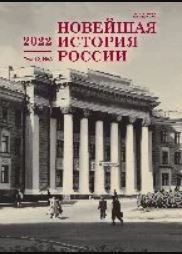Советская кинополитика второй половины 1950 - конца 1970-х годов
Soviet Film Policy of the Second Half of 1950s - Late 1970s
Author(s): Kirill A. YudinSubject(s): Politics, Political history, Post-War period (1950 - 1989), Film / Cinema / Cinematography
Published by: Издательство Исторического факультета СПбГУ
Keywords: cinema; Soviet film policy; Cold War; Cold Warming; détente; ideology; political control; USSR;
Summary/Abstract: The subject of this article is the film policy of the Soviet leadership in the period of “cold warming.” The term is used as a conditional-instrumental designation of the period — the second half of the 1950s to the late 1970s, clearly manifested as a management style in which elements of “détente” in the field of culture, cinematography, which appeared much earlier than this phenomenon in international relations, continuously coexisted with an atmosphere of tension between the USSR and the USA. On the basis of a wide range of sources, including archival documents used here or are subjected to in-depth analysis for the first time, this article addresses political, ideological, institutional, media, and communicative aspects of Soviet film politics in historical dynamics, from Khrushchev’s “modernization” to Brezhnev’s “conservative appeasement”. The leading role of such structures as the USSR State Committee for Cinematography, film export organization, and Ideological Commissions of the Central Committee of the CPSU in following established traditions of state pragmatism is established. This was expressed in the opening of external information “gateways” on the principle of duality. Import and “free” transmission of foreign film production, the assumption of private and departmental interaction with Western, American cinema figures, the reception of “alien” artistic and administrative-organizational experience of improving the filmmaker, were interrupted by strict control, demonstrative strengthening of censorship, and control and supervisory activity of party-state structures to counter “bourgeois media attacks”. As a result, this led to the return of excessive ideological and political principles, the inertial construction of barriers, the re-conceptualization of figurative-visual stereotypes and dogmatic prejudices.
Journal: Новейшая история России
- Issue Year: 12/2022
- Issue No: 40
- Page Range: 752-773
- Page Count: 22
- Language: Russian

